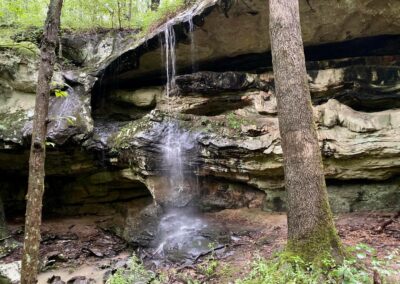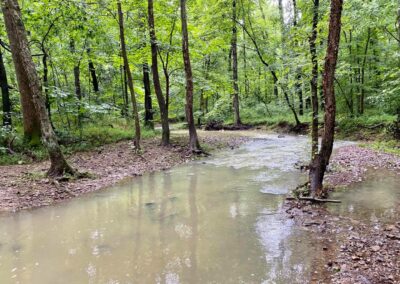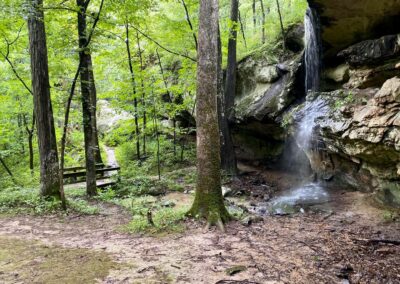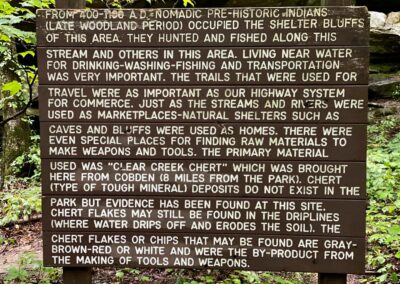Giant City Indian Creek Trail Guide
Giant City Indian Creek Trail is a short but scenic hike that is often overlooked by many people enjoying a visit to Giant City State Park.
Like with most things with the word “Indian” in the name, this trail has some Native American history to it.
This is an excellent trail for people of all ages looking for a short hike with a lot to see.
Directions to Giant City Indian Creek Trail
Click this Google Maps Page to see how to get to the Giant City Indian Creek Trail from Carbondale.
WINTER TRAVEL: Giant City State Park is hilly, and conditions could be hazardous if wintry precipitation has fallen. Please use caution when visiting the park after winter events. At times, the roads throughout the park will be a priority for snow removal. It is essential to have a plan B, just in case.
PUBLIC HEALTH: Please see the Illinois Department of Natural Resources (IDNR) website for any public health or safety closures within Giant City State Park. Try to have a Plan B just in case access is restricted within the park.
Trail Information for Giant City Indian Creek Trail
The Giant City Indian Creek Trail is right under a mile in length. This is a loop trail. Less than 50′ of elevation gain makes it easy for most hikers. The hike should take about 15 to 30 minutes, depending on how slow you walk.
This trail is not blazed. However, it is used enough that navigating it will be evident and straightforward. There are sturdy bridges provided over the creeks for easy access by hikers. Visitors should remain on the designated trail at all times.
During firearms hunting season, this trail is closed to hikers. This is because the woods beside the trail are used for hunting activities. For more information about hunting seasons and closures, visit the Illinois Department of Natural Resources (IDNR) Hunting Information website.
Pets are OK as long as they are on a leash.
TRAIL HAZARDS: You should be aware of some hazards associated with this trail.
- During wet and wintry conditions, this trail will be slippery. Please use caution.
- Dangerous conditions exist within this area. Please be cautious around cliff edges.
- Poison ivy and briers occur in this area. Avoid contact by staying on designated trails.
- Venomous copperhead snakes do occur along this trail. Therefore, watch your step at all times.
- Mosquitoes, ticks, and biting flies occur during the warmer months.
What You Will See along the Indian Creek Trail Hike
For such a short hike, there is a lot to see along the Giant City Indian Creek Trail.
Each season in Southern Illinois brings something new to see along this hike. In the summer, everything is green and vibrant. In the fall, the colors of the leaves change. In the winter, you can see everything. In the spring, wildflowers bloom, and the forest wakes up from the winter.
You’ll enjoy lovely views of the hardwood forest at the start of your hike (assuming you go counterclockwise). Look around at dead logs and such for interesting mushrooms.
You’ll reach the Indian Creek area. Bridges allow you to cross the creek without getting wet. The creek is very scenic, unlike many other Southern Illinois creeks, which are usually full of dirty brown water. There are a lot of pretty rocks along the creek.
As you continue into the bluff area on your right, these are the areas where Native Americans used chert to create their arrowheads and other tools. Do remember that digging for and collecting artifacts is prohibited at Giant City Indian Creek Trail and the rest of the state park, for that matter.
On wetter days, you can enjoy a nice waterfall along the bluffs. However, if it has been wet and below freezing, the waterfall might be frozen.
As you wind back towards the start of the loop, you enjoy more scenic views of the creek and the hardwood forest around you. Notable trees include the Tulip, Sycamore, Cottonwood, Black Willow, and River Birch.
History of the Giant City Indian Creek Trail
The natural history of this area can be aligned with an ancient sea that once flowed through southern Illinois. It created bluffs and mountains along the path in other states during that period. The bluffs can essentially be considered a part of the creation of the mountains. This was long before humans existed. These bluffs are the most ancient thing you can see and touch in the forest.
Around 400 to 900 A.D., the area was inhabited by the Native Americans from the Late Woodland period. These early people dwelled at the bluffs and used abundant forest, plants, and wildlife to survive. These early Native Americans were around long before European settlers arrived.
In the 1920s, Illinois gained the property where the Giant City Indian Creek Trail is and created the state park. In the 1930s and 40s, the Civilian Conservation Corps (CCC) created many roads, trails, drainage systems, cabins, and the lodge.
Today the state park is used by many hikers, equestrians, climbers, cyclists, and more.
Other Stuff To Do Around the Indian Creek Trail
There are many hiking opportunities nearby on the Giant City Indian Creek Trail. Enjoy three other great loop hiking trails in the park, including Trillium Trail, the park’s Nature Preserve, Nature Trail, where you can see carvings from the Civil War era, and the Stonefort Trail to catch a glimpse of a Native American past. Giant City State Park has many other hiking and equestrian trails.
For upcoming park events, park merchandise, and visitor information – be sure to stop by the Giant City Visitor Center.
For lodging in the area, you have several options. Electric and non-electric camping is available at the Giant City Campground. You can rent cabins in the park, too. There is a campground for horseback riders in the park. Check out the nearby Makanda Inn for a more elegant lodging experience. Finally, there are hotels available in the nearby City of Carbondale.
For dining, check out the Giant City Lodge, known for having the best-fried chicken in southern Illinois. In addition, Carbondale has numerous international, gluten-free, and vegan dining options.
Stop by Makanda Boardwalk for local gifts, unique products, and snacks.
The Shawnee Hills Wine Trail also runs through this area.
Check out Southernmost Illinois, Union County Tourism, and Carbondale Tourism for more events and places to visit around the Giant City Indian Creek Trail.
Please Support Hiking with Shawn
Alrighty folks, I hope you have enjoyed this content. I provide it for free and it takes a while to create. If you would be so kind enough to support my efforts, you can do so by sharing this post with others, especially on social media. Be sure to subscribe to my YouTube Channel to see my latest videos, shorts and live streams. Follow me on Facebook, Instagram, Twitter and TikTok for unique content that you will only find on those pages. You might also join my Southern Illinois Hiking & Outdoor Resources Group on Facebook, too!
You can also support me by becoming a Patreon Supporter for as little as $3/month and you can cancel anytime (no contracts or catches). Patreons get access to extra features, exclusive articles, sticker packs, gifts and more. Consider buying official Hiking with Shawn Merchandise as another way to support me. I spend a lot of money on Hiking with Shawn and because of extremely high public land permit fees, I make very little money in return so everything helps.
Thanks again for checking out another one of my articles and until next time, I’ll see you on the trail!
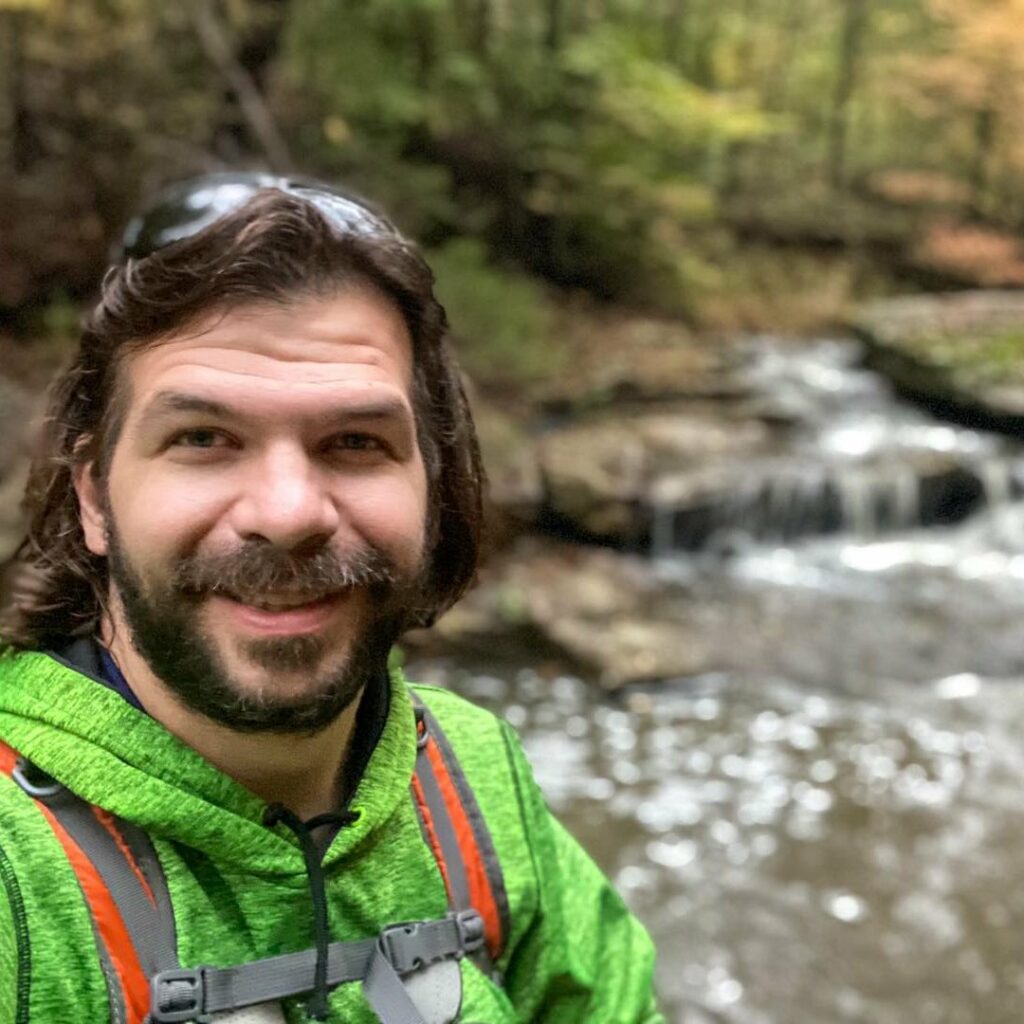
Shawn Gossman
Founder, Hiking with Shawn
Howdy folks! My name is Shawn Gossman and I founded Hiking with Shawn. I’m an avid hiker, cyclist and outdoorsman here in the Shawnee National Forest. I was born and raised in Southern Illinois and never want to leave. Click here to learn more about Shawn Gossman

